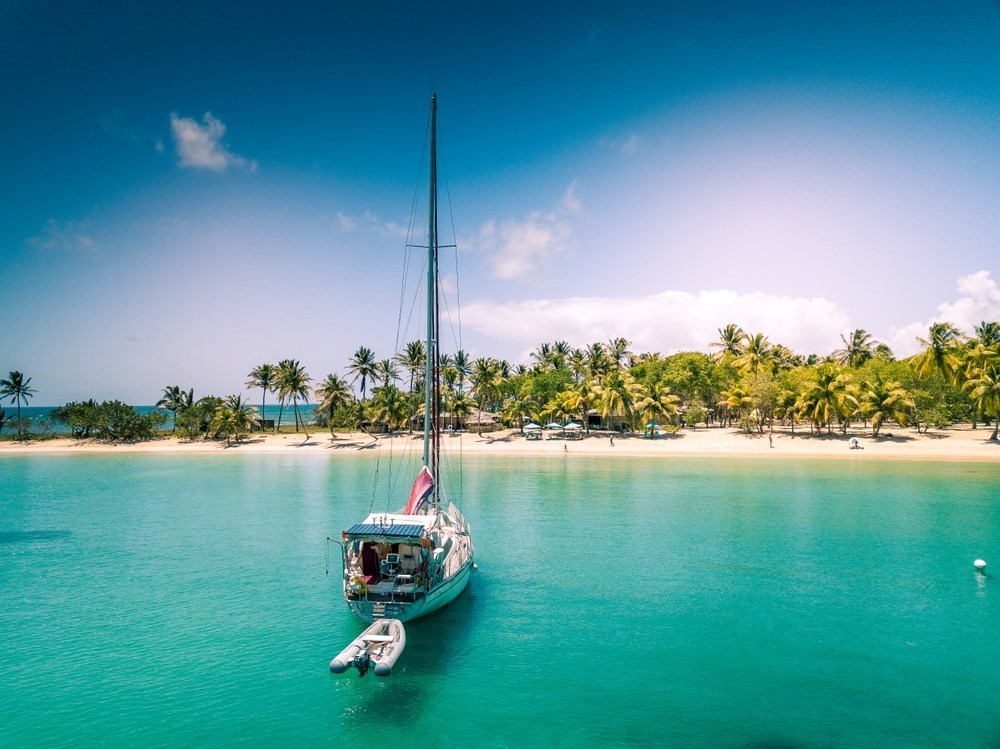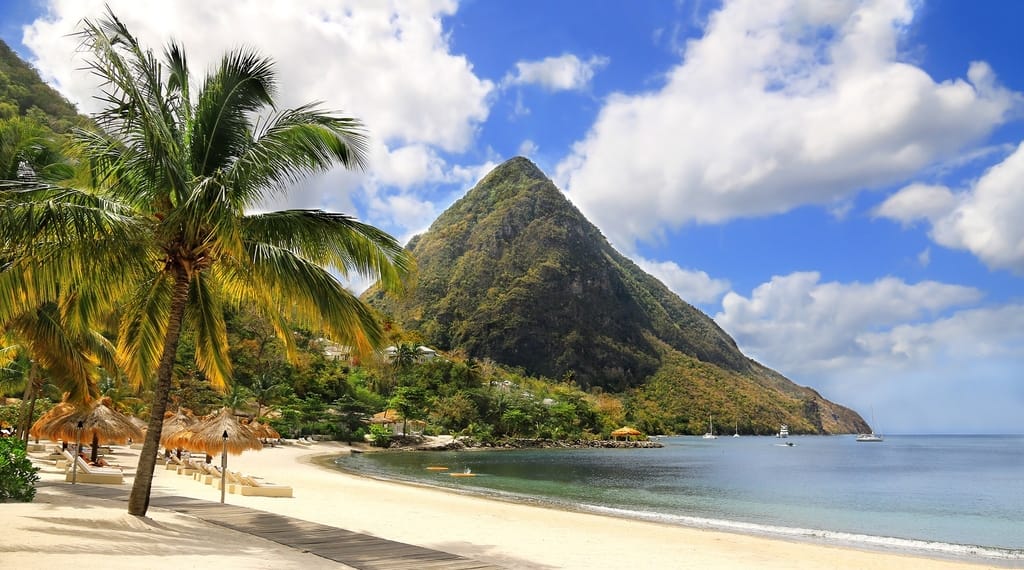Best Sailing Destinations in the Caribbean
The Caribbean is a sailing area that offers a plethora of choices for all kinds of sailors. And, that’s why it’s among the most popular and loved destinations. Also, the islands’ year-round sunny weather, exotic landscapes, and favorable seas make them a great place to go sailing in the winter. Warm winds, crystal clear cerulean waters, and natural scenery that hasn’t been unspoiled yet. With so many magnificent sites in the Caribbean Sea, you have a plethora of options for sailing. You can sail in some parts of the Caribbean no matter your level of sailing experience. You can do it even if you are a beginner, depending on where you depart from. So, let’s move on and see the best sailing destinations in the Caribbean. Keep reading!
Best Months to Sail in the Caribbean
When it comes to weather, the Caribbean is known for having possibly the most desirable climate in the world, with year-round temperatures ranging from 24 to 29 degrees Celsius. It’s never cold, never hot, and the rains follow a fairly consistent pattern, keeping these tropical islands lush and green. The greatest season to visit the Caribbean is from December to April, when temperatures are slightly colder (particularly in the northern Caribbean), the weather is drier, and the humidity is lower. Sailors love the Caribbean’s low season, which runs from May through October. The weather is typically humid around this season, with a higher probability of rain, but you’ll still get plenty of warm temperatures and sun.
The hurricane season in the Caribbean runs from June 1st to November 30th, with September and October being the most dangerous months. Many people avoid the Caribbean during this time but keep in mind that not all areas are similarly afflicted. The southeastern islands have the fewest hurricanes, whereas the southwestern and northeastern United have the most. Because storms tend to move away from the equator, southern places such as the Dutch Caribbean islands of Aruba, Bonaire, and Curacao are mostly unaffected. Barbados is relatively hurricane-free, with only approximately one every 20 years. The islands in the hurricane belt, particularly those in the north, such as the Bahamas, Cuba, and Turks & Caicos, are the most vulnerable.
Best Sailing Destinations in the Caribbean
Barbados
Barbados, a beautiful coral island, is only 166 square kilometers in size and is located 98 miles east of the West Indies. One of Barbados’ principal marinas is located in Port St. Charles, and it can provide overnight protection for your boat if you’re on a longer voyage. Barbados’ vast shoreline hides subterranean caves and underground lakes in addition to its unending white sand beaches. Above ground (but underwater), you’ll discover some of the best snorkeling in the world, with friendly sea turtles frequently present. Not to mention the island’s stunning tidal pools and world-class surfing. Barbados has a very rich culture and history in addition to these beautiful natural occurrences. While you drop anchor in one of the picturesque beach villages, visit the mainland and see some of the historic plantations.

Saint Lucia
Saint Lucia is a Caribbean territory popular for its spectacular hilly islands and wonderful sailing conditions. Many of St Lucia’s top activities revolve around nature, which is understandable given the island’s abundance of waterfalls, lush jungles, soaring peaks, and secret beaches. On land, the true Creole culture and laid-back attitude give you a taste of the Caribbean, while the year-round trade winds are perfect for exploring the coast. In fact, one of the nicest views on the island is from the surrounding waterways, therefore Saint Lucia is a great area for sailors. Some of the not-to-miss activities in St.Lucia are hiking in the Pitons and taking a mud bath at the Sulphur Springs.
Guadeloupe
Guadeloupe is a Leeward Island with a unique butterfly shape. Pointe-à-Pitre, the island’s major city is located on Grande-Terre in the east while Basse-Terre, the capital, is on the west. A narrow channel known as the Salt River separates the island’s two halves. The western wing, Basse-Terre, is less urbanized and home to a significant national park. Close by are Marie Galante, which has good snorkeling, and the Gosier islet, which has a large coral reef. Sailing to the island of Les Saintes and surrounding Fort Napoleon on Terre-de-Haut, where there are various anchorages, is also an option. Don’t forget to visit Jacques Cousteau’s Underwater Reserve, which is near Pigeon Island and contains a variety of colorful coral forests and plenty of marine life.
Martinique
Another French-Caribbean island with spectacular natural beauty and rich culture. It’s a lot to take in, from the rough and lush environment in the north to the lovely white-sand beaches in the south, all topped off with views of the famous Mont Pelée volcano. The capital, Fort-de-France, is also brimming with cultural attractions and fascinating history, and it’s a fun place to get lost in. There are several museums, architectural marvels, small lanes, and local markets to explore. Martinique has a subtropical climate, with daytime temperatures ranging from 19 to 30 degrees Celsius. You can visit at any time of year, but the months of December to June have the least rain, with winds ranging from 10-15 mph and blowing from the east.

Antigua and Barbuda
Antigua and Barbuda are part of the Lesser Antilles, which form the eastern arc of the Leeward Islands. The islands are known for their excellent sailing waters, consistent trade winds, and numerous coves and lovely beaches, all of which create a fantastic sailing experience. Antigua is the largest of the English-speaking Leeward Islands, measuring 14 miles long and 11 miles wide. It benefits from a warm climate moderated by consistent trade winds, as do most Caribbean islands. With its complicated coastline, a number of secure harbors, and almost unbroken protective coral reef surrounding the island, the location is one of the world’s most coveted sailing destinations. Antigua is believed to have 365 different beaches, one for each day of the year, so there’s much to view while sailing there. Antigua is a flower-shaped island with many endemic flora and fauna species and beautiful beaches.
>>Also Read: Cheap Marinas for Long-term Docking in the Caribbean
The British Virgin Islands
The Virgin Islands belong in the Leeward Islands’ northern region. The British Virgin Islands are an overseas territory of the United Kingdom. It consists of more than 50 islands, just 16 of which are inhabited. The major islands are Tortola, Virgin Gorda, Anegada, and Jost van Dyke; all but Anegada are volcanic. Smaller islands include Peter Island, Beef Island, Salt Island, Cooper Island, and Norman Island. The region is renowned as the Caribbean Sea’s sailing capital for a reason: it is the area’s most popular sailing destination, where anyone, regardless of skill level, can choose their preferred route. Sailing is pleasant all year due to the trade winds and moderate climate. December through April is the mid and high season but there’s no risk of hurricanes. May and June are also great months to visit and the islands are less crowded.

The Cayman Islands
The Cayman Islands, which include the islands of Grand Cayman, Cayman Brac, and Little Cayman, are a British overseas territory in the western Caribbean Sea. You will find safe and beautiful anchorages there and a rocky coastline, as well as fantastic beaches and relaxing atmosphere. The weather is tropical and warm, and the islands aren’t far from the mainland US. There is a wet season from May to October and a dry season from November to April on the islands. Tropical cyclones that emerge during the Atlantic hurricane season, which runs from July to November, are another important natural danger that you have to be aware of before sailing there.
Saint Vincent and the Grenadines
St. Vincent and the Grenadines is a chain of 32 islands and cays, just nine of which are inhabited. To the north of St.Vincent it’s Saint Lucia and to east Barbados Island. Some of the greatest islands to sail in the region are Bequia, Young Island, Tobago Cays, Union Island, and Mayreau. Saint Vincent and the Grenadines are one of the world’s most popular locations for sailors, due to the numerous uncrowded anchorages and natural landscapes. St. Vincent, sometimes known as “the mainland,” is over 18 miles long and is dominated by the La Soufrière volcano, which last erupted on March 9th, 2021. Consider visiting the Falls of Baleine, breathtaking cascades only accessible by boat and anchor in Cumberland Bay. Moreover, the spacious and verdant valleys of the Mesopotamia region, the island’s breadbasket, with rows of banana plants, are among St. Vincent’s other natural beauties.
Grenada
Many sailors are drawn to Grenada because of its rugged, hilly interior, jungles and waterfalls, and the fact that it is less visited than other Caribbean sailing locations. There are so many sailing and anchoring choices in Grenada and the Grenadines that it’s difficult to see them all. Grenada consists of a chain of islands that includes Grenada, Carriacou, and Petite Martinique. Because it is a major producer of cinnamon, cloves, ginger, mace, allspice, and nutmeg, the country is known as the Spice Isle. Grenada’s weather is difficult to beat. With a hot, tropical climate year-round, average temperatures range between 24 and 30 degrees Celsius. The driest months are January to May, while June to December sees rain in brief, intense showers.

>>Also Read: Is It Dangerous to Sail in the Caribbean?
Dominica
Dominica is part of the Windward Islands, it is largely covered in rainforest and has the world’s second-largest boiling lake. On Dominica, there are various waterfalls, springs, and rivers. Some plants and creatures considered to be extinct on nearby islands can still be found in Dominica’s woods. Due to its volcanic nature and lack of sandy beaches, Dominica is a popular scuba diving destination. This island country features multiple exceptional diving spots due to its huge drop-offs, healthy marine environment, and reefs. Cabrits National Park is one of Dominica’s several protected areas. Dominica also has 365 rivers in total. Prince Rupert Bay, in Portsmouth, on the northwest coast of the island, is a great harbor. Unless you’re in the shallows during an SW wind, it’s also safe from inclement weather.
Saint Martin
Sailing in St. Martin gives you the opportunity to visit some of the most beautiful islands in the eastern Caribbean, such as St. Martin, Anguilla, and St. Barts. Divers and snorkelers can experience some of the world’s most beautiful and pristine reefs. St. Martin is part of the Leeward Islands in the Caribbean Sea, roughly 150 miles north of Guadeloupe. It is the world’s tiniest land, shared by two sovereign nations, France and the Netherlands. Although St Martin does not have a distinct rainy season like its surrounding islands, the best time to sail is between January and June when the chances of rain are the lowest. Sailing between February and April is the best time for exploring Saint Martin. Lastly, note that the trade winds blow from December to March, then again from June to August, with hurricane season falling between July and November.
